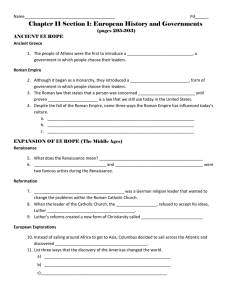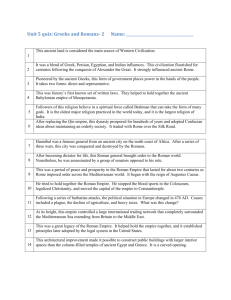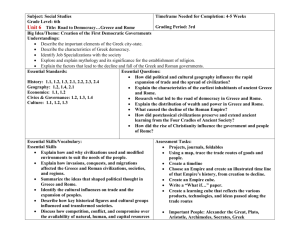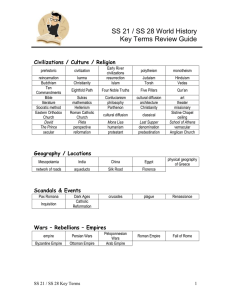GREECE-ROME REGENT QUESTIONS
advertisement
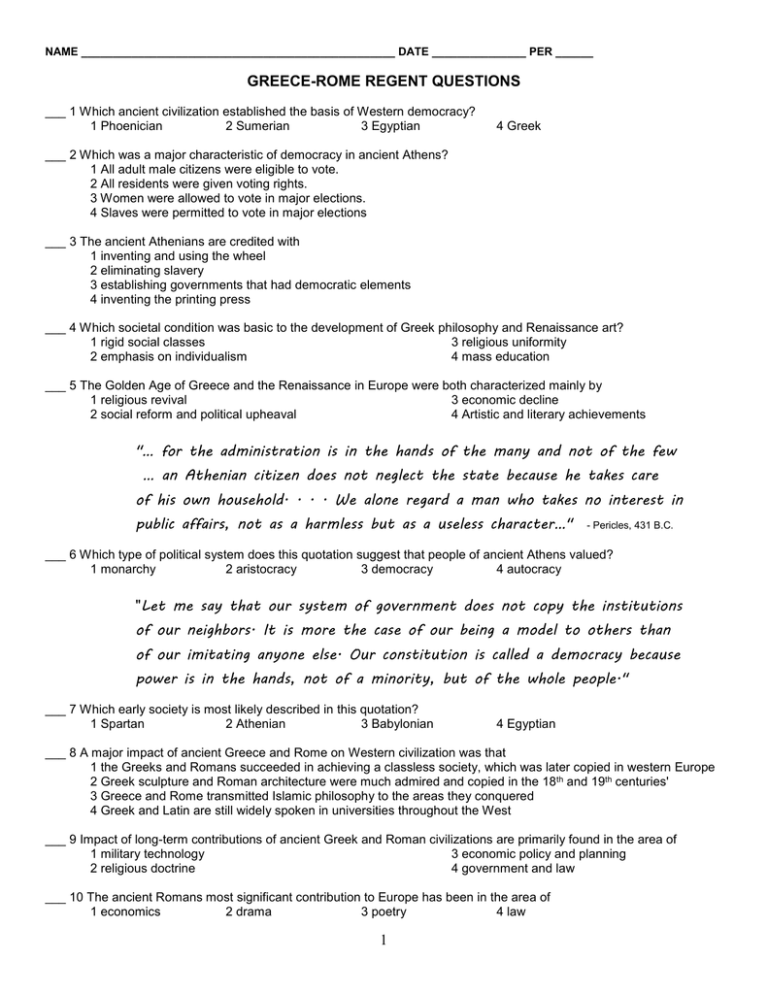
NAME __________________________________________________ DATE _______________ PER ______ GREECE-ROME REGENT QUESTIONS ___ 1 Which ancient civilization established the basis of Western democracy? 1 Phoenician 2 Sumerian 3 Egyptian 4 Greek ___ 2 Which was a major characteristic of democracy in ancient Athens? 1 All adult male citizens were eligible to vote. 2 All residents were given voting rights. 3 Women were allowed to vote in major elections. 4 Slaves were permitted to vote in major elections ___ 3 The ancient Athenians are credited with 1 inventing and using the wheel 2 eliminating slavery 3 establishing governments that had democratic elements 4 inventing the printing press ___ 4 Which societal condition was basic to the development of Greek philosophy and Renaissance art? 1 rigid social classes 3 religious uniformity 2 emphasis on individualism 4 mass education ___ 5 The Golden Age of Greece and the Renaissance in Europe were both characterized mainly by 1 religious revival 3 economic decline 2 social reform and political upheaval 4 Artistic and literary achievements "… for the administration is in the hands of the many and not of the few … an Athenian citizen does not neglect the state because he takes care of his own household. . . . We alone regard a man who takes no interest in public affairs, not as a harmless but as a useless character…" - Pericles, 431 B.C. ___ 6 Which type of political system does this quotation suggest that people of ancient Athens valued? 1 monarchy 2 aristocracy 3 democracy 4 autocracy "Let me say that our system of government does not copy the institutions of our neighbors. It is more the case of our being a model to others than of our imitating anyone else. Our constitution is called a democracy because power is in the hands, not of a minority, but of the whole people." ___ 7 Which early society is most likely described in this quotation? 1 Spartan 2 Athenian 3 Babylonian 4 Egyptian ___ 8 A major impact of ancient Greece and Rome on Western civilization was that 1 the Greeks and Romans succeeded in achieving a classless society, which was later copied in western Europe 2 Greek sculpture and Roman architecture were much admired and copied in the 18th and 19th centuries' 3 Greece and Rome transmitted Islamic philosophy to the areas they conquered 4 Greek and Latin are still widely spoken in universities throughout the West ___ 9 Impact of long-term contributions of ancient Greek and Roman civilizations are primarily found in the area of 1 military technology 3 economic policy and planning 2 religious doctrine 4 government and law ___ 10 The ancient Romans most significant contribution to Europe has been in the area of 1 economics 2 drama 3 poetry 4 law 1 ___ 11 The political system of the ancient Roman Empire was characterized by 1 a strong central government 2 rule by a coalition of emperors and religious leaders 3 universal suffrage in national elections 4 a strict adherence to constitutional principles ___ 12 An immediate result of the fall of the Roman Empire was 1 a renewed interest in education and the arts 2 a period of disorder and weak central government 3 an increase in trade and manufacturing 4 the growth of cities and dominance by the middle class' "Western Europe owed a debt of gratitude to the Empire that for almost a thousand years ensured the survival of Christianity during a time when Europe was too weak to accomplish the task." ___ 13 Which empire is referred to in this quotation? 1 Hellenistic 2 Byzantine 3 Mongol 4 Ottoman ___ 14 Rome during the Pax Romana and the Catholic Church during the Middle Ages are examples of 1 constitutional monarchies 3 feudal governments 2 centralized powers 4 Communist regimes ___15 A major reason for the decline of the Roman Empire was 1 a series of military defeats in Africa 2 political corruption and the instability of the government 3 the abolition of slavery through out the Empire 4 continued acceptance of traditional religions ___ 16 Which characteristic was common to the Golden Age of Greece and the Italian Renaissance 1 A strong military led to national unity. 2 Written constitutions led to the establishment of democratic governments. 3 Prosperity led to the creation of many works of art. 4 Political instability led directly to the formation of unified nation-states. ___ 17 A major effect of the decline of the Roman Empire was that western Europe 1 came under the control of the Muslims 3 returned to a republican form of government 2 was absorbed by the Byzantine Empire 4 entered a period of chaos and disorder ___ 18 After the fall of Rome, the eastern portion of the Roman Empire became known as the 1 Persian Empire 2 Mongol Empire 3 Byzantine Empire 4 Gupta Empire ___ 19 All citizens in ancient Athens had the right to attend the Assembly, where they could meet in open discussion and cast votes. This situation is an example of 1 direct democracy 3 parliamentary democracy 2 totalitarianism 4 absolutism ___ 20 A major contribution of the Roman Empire to Western society was the development of 1 gunpowder 3 monotheism 2 the principles of revolutionary socialism 4 an effective legal system ___ 21 Which European historical periods are in the proper chronological order? 1 Middle Ages Renaissance Ancient Greece Roman Empire 2 Renaissance Ancient Greece Roman Empire Middle Ages 3 Ancient Greece Roman Empire Middle Ages Renaissance 4 Roman Empire Middle Ages Renaissance Ancient Greece 2

